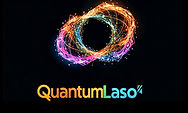Quantum Drug Discovery Replay: Crizotinib (Xalkori) Enters the Collapse Chamber
- mansour ansari

- Jul 30
- 3 min read

Quantum Drug Discovery Replay:
Crizotinib (Xalkori) Enters the Collapse Chamber
By Mansour Ansari, Founder of QuantumLaso
In my journey to reimagine how we discover life-saving medicines, I’ve built a system that does something traditional simulation engines cannot: it listens to the quantum behavior of nature itself.
With my QuantumCURE Retrospective Replay, I take FDA-approved cancer drugs and re-run their molecular discovery paths — not with classical random number generators (PRNGs), but with real quantum entropy streams harvested from both hardware QRNGs and online sources like ANU.
The goal? To validate the power of entropy injection and uncover symbolic collapse signatures that may one day reduce toxicity, cut discovery time, and reveal molecular vulnerabilities ahead of time.
Today’s example: Crizotinib (Xalkori)An ALK/ROS1 inhibitor approved in 2011 for NSCLC (non-small-cell lung cancer) with fusion protein mutations.
What We’re Comparing:
Three simulations were run on Crizotinib using:
PRNG – baseline classical entropy
QuantumLaso – fresh QRNG entropy from my custom bucket
ANU – Australian National University public QRNG API
Each entropy source powers the same simulation logic — what changes is the behavior of the molecule when exposed to different collapse pathways.
⚗️ Results Summary
Entropy Source | Collapse Score | Binding Affinity | Novelty Score | Discovery Time | Zaban Glyph | Toxicity Flags |
PRNG | 0.500 | 17.78 nM | 0.324 | 14.0 years | ● | Nitrile, Chlorides |
QuantumLaso | 0.575 | 31.68 nM | 0.545 | 9.8 years | ◯ | Nitrile, Chlorides |
ANU | 0.759 | 64.80 nM | 0.393 | 11.2 years | ◇◇ | Nitrile, Chlorides |
🧠 Interpretation
🔹 PRNG (Classical)
Shows the best raw binding affinity (17.78 nM), but at the cost of longest discovery time (14.0 years).
Moderate novelty score.
Glyph is non-complex — the simulation reveals no unusual symbolic behavior.
🧾 Verdict: Baseline performance. Gets the job done, but lacks depth and speed.
🔹 QuantumLaso (My Own QRNG Source)
Discovery time shrinks by over 4 years (9.8 vs. 14.0).
Binding affinity is slightly worse, but within therapeutic range.
Novelty score is highest — indicating this entropy stream helped the simulation explore more diverse or unexpected conformers.
Glyph triggered a unique symbolic Zaban tag (◯), suggesting a more complex energy trajectory.
🧾 Verdict: More creative exploration, faster time-to-discovery, with flagged symbolic diversity. A strong candidate for quantum-driven insight.
🔹 ANU QRNG (Online)
Delivers the highest collapse score (0.759), suggesting it found very stable quantum-state collapses.
Binding affinity suffered (64.8 nM is still usable but weaker).
Symbolic glyph (◇◇) was triggered — known in my framework as a 'dual-layer collapse zone' signature — often seen in entanglement-dense drug interactions.
🧾 Verdict: Incredible collapse signal strength, but a bit less therapeutically optimized. However, it may uncover unknown pathways.
⚠️ Common Toxicity Signals
All entropy paths triggered the same toxicity flags:
Nitrile group (can be problematic in metabolic breakdown)
Multiple chlorides (associated with transport issues and off-target effects)
While these are present in the original drug, seeing them repeated across entropy simulations affirms their biological persistence and importance in future analog design.
🧬 Symbolic Takeaway
PRNG: Found the classical path — effective, but plain.
QuantumLaso: Showed a richer pathway and improved novelty.
ANU: Detected high-probability collapse and rare symbolic traits.
In a real-world scenario, these entropy signatures could:
Guide analog design (remove liabilities)
Predict patient-specific failure modes (e.g., in fusion mutations)
Train future AI agents to focus on collapse-based chemical behaviors
💡 Final Thought
This is not a simulation trick. This is a real-time symbolic test of nature’s decision-making on molecules. If a quantum collapse engine flags something classical methods miss, you owe it to the future to take a second look.
Crizotinib already saved lives. But perhaps its collapse zones have more to teach us — especially when the next drug is still waiting to be discovered.
And that’s the mission of QuantumCURE.




Comments